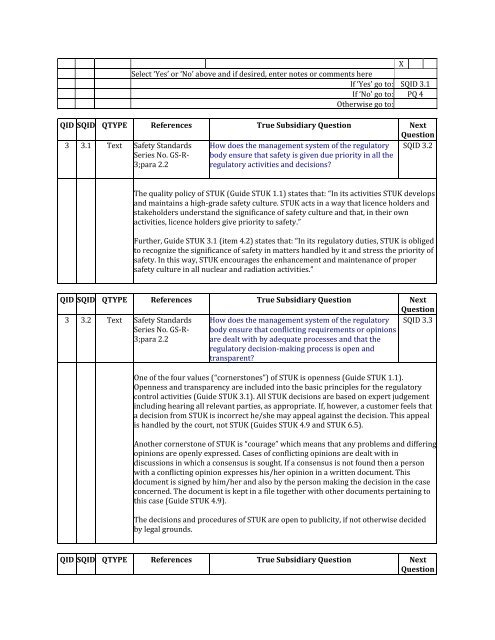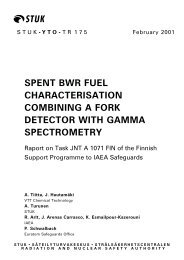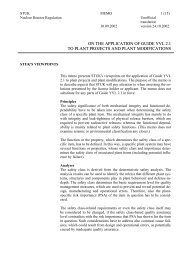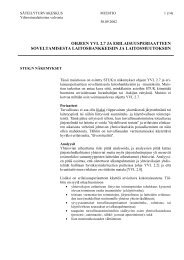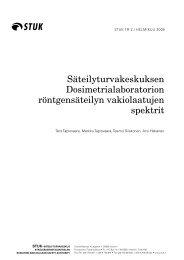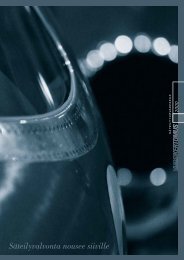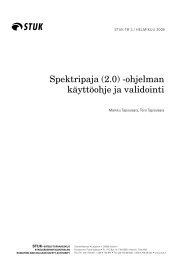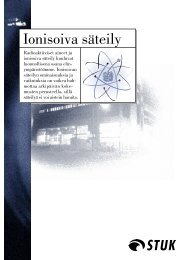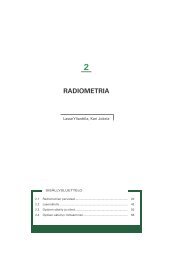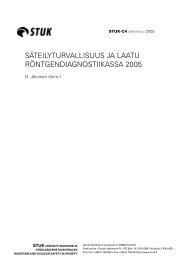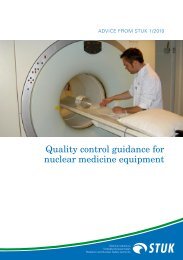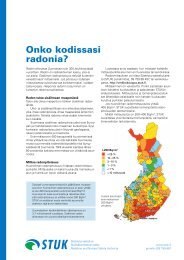Core Questions (GSR Part 1 and GS-R-3) Primary Module ... - STUK
Core Questions (GSR Part 1 and GS-R-3) Primary Module ... - STUK
Core Questions (GSR Part 1 and GS-R-3) Primary Module ... - STUK
Create successful ePaper yourself
Turn your PDF publications into a flip-book with our unique Google optimized e-Paper software.
X<br />
Select ‘Yes’ or ‘No’ above <strong>and</strong> if desired, enter notes or comments here<br />
If ‘Yes’ go to: SQID 3.1<br />
If ‘No’ go to: PQ 4<br />
Otherwise go to:<br />
QID SQID QTYPE References True Subsidiary Question Next<br />
Question<br />
3 3.1 Text Safety St<strong>and</strong>ards<br />
Series No. <strong>GS</strong>-R-<br />
3;para 2.2<br />
How does the management system of the regulatory<br />
body ensure that safety is given due priority in all the<br />
regulatory activities <strong>and</strong> decisions?<br />
SQID 3.2<br />
The quality policy of <strong>STUK</strong> (Guide <strong>STUK</strong> 1.1) states that: “In its activities <strong>STUK</strong> develops<br />
<strong>and</strong> maintains a high-grade safety culture. <strong>STUK</strong> acts in a way that licence holders <strong>and</strong><br />
stakeholders underst<strong>and</strong> the significance of safety culture <strong>and</strong> that, in their own<br />
activities, licence holders give priority to safety.”<br />
Further, Guide <strong>STUK</strong> 3.1 (item 4.2) states that: “In its regulatory duties, <strong>STUK</strong> is obliged<br />
to recognize the significance of safety in matters h<strong>and</strong>led by it <strong>and</strong> stress the priority of<br />
safety. In this way, <strong>STUK</strong> encourages the enhancement <strong>and</strong> maintenance of proper<br />
safety culture in all nuclear <strong>and</strong> radiation activities.”<br />
QID SQID QTYPE References True Subsidiary Question Next<br />
Question<br />
3 3.2 Text Safety St<strong>and</strong>ards<br />
Series No. <strong>GS</strong>-R-<br />
3;para 2.2<br />
How does the management system of the regulatory<br />
body ensure that conflicting requirements or opinions<br />
are dealt with by adequate processes <strong>and</strong> that the<br />
regulatory decision-making process is open <strong>and</strong><br />
transparent?<br />
SQID 3.3<br />
One of the four values (“cornerstones”) of <strong>STUK</strong> is openness (Guide <strong>STUK</strong> 1.1).<br />
Openness <strong>and</strong> transparency are included into the basic principles for the regulatory<br />
control activities (Guide <strong>STUK</strong> 3.1). All <strong>STUK</strong> decisions are based on expert judgement<br />
including hearing all relevant parties, as appropriate. If, however, a customer feels that<br />
a decision from <strong>STUK</strong> is incorrect he/she may appeal against the decision. This appeal<br />
is h<strong>and</strong>led by the court, not <strong>STUK</strong> (Guides <strong>STUK</strong> 4.9 <strong>and</strong> <strong>STUK</strong> 6.5).<br />
Another cornerstone of <strong>STUK</strong> is “courage” which means that any problems <strong>and</strong> differing<br />
opinions are openly expressed. Cases of conflicting opinions are dealt with in<br />
discussions in which a consensus is sought. If a consensus is not found then a person<br />
with a conflicting opinion expresses his/her opinion in a written document. This<br />
document is signed by him/her <strong>and</strong> also by the person making the decision in the case<br />
concerned. The document is kept in a file together with other documents pertaining to<br />
this case (Guide <strong>STUK</strong> 4.9).<br />
The decisions <strong>and</strong> procedures of <strong>STUK</strong> are open to publicity, if not otherwise decided<br />
by legal grounds.<br />
QID SQID QTYPE References True Subsidiary Question Next<br />
Question


